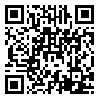دوره 3، شماره 4 - ( زمستان 1401 )
جلد 3 شماره 4 صفحات 39-19 |
برگشت به فهرست نسخه ها
1- دانشجوی دکتری،گروه جغرافیا،دانشکده ادبیات و علوم انسانی،دانشگاه لرستان، خرم آباد، ایران
2- استادیار گروه جغرافیا،دانشکده ادبیات و علوم انسانی،دانشگاه لرستان، خرم آباد، ایران ،karampoor.m@lu.ac.ir
3- دانشیار گروه جغرافیا،دانشکده ادبیات و علوم انسانی،دانشگاه لرستان، خرم آباد، ایران
2- استادیار گروه جغرافیا،دانشکده ادبیات و علوم انسانی،دانشگاه لرستان، خرم آباد، ایران ،
3- دانشیار گروه جغرافیا،دانشکده ادبیات و علوم انسانی،دانشگاه لرستان، خرم آباد، ایران
چکیده: (1738 مشاهده)
امروزه در زمینۀ مطالعه و توضیحات سیستم یکپارچه مبتنی بر کاربرد ماهوارهها برای نظارت و پیش بینی شرایط محیطی زمین در بلندمدت و کوتاهمدت و فعالیتهای اقتصادی وابسته به آب و هوا ماهوارههای مختلفی بهکار گرفته شدهاند. این سیستمها بر اساس روش سنجش از دور یا مشاهدات ماهوارهای از زمین، نظریه بیوفیزیکی پاسخ گیاهان به شرایط اقلیمی، مجموعهای از الگوریتمهای پردازش دادههای ماهوارهای، تفسیر، توسعه محصول، اعتبار سنجی، کالیبراسیون و کاربردها را شامل میشود. مشاهدات جدید ماهوارهای عمدتاً توسط تصاویر پیشرفته مادون قرمز که بسیار کارآمد هستند، نشان داده میشوند. در این رابطه، استفاده از روشهای سنجش از دور، جهت پایش و بررسی اثرات بارش دریافتی بر پوشش گیاهی، به عنوان یکی از کارآمدترین روشها شناخته شده است. به منظور آشکار سازی تاثیر بارش بر پوشش گیاهی ، جهت محاسبه میانگین ماهانه (SPI) دادههای بارش 13 ایستگاه هواشناسی سینوپتیک مورد استفاده قرار گرفت. سپس با استفاده از تصاویر مادون قرمز به صورت میانگین هفتگی2021-2013 (اول آوریل تا پایان ژولای)، به بررسی وضعیت پوشش گیاهی پرداخته شد. میزان همبستگی (SPI) با شاخصهایNDVI ،TCI ،VCI وVHI به ترتیب 050/0، 069/0، 0027/0، 0025/0 میباشد. شاخص (VCI) همبستگی بیشتری با (SPI) دارد که میتواند به عنوان یک روش ترکیبی از سنجش از دور و اطلاعات ایستگاههای هواشناسی (SPI) برای بررسی شرایط پوشش گیاهی در استان کرمانشاه مناسب باشد. پوشش گیاهی همه ساله با درجات مختلفی از خشکسالی رو به رو بوده است. شدیدترین خشکسالی پوشش گیاهی در 2015 در قسمت های مرکزی، جنوبی و شمال شرقی استان رخ داده است. در 2013 خشکسالی با شدت کمتری نیز رخ داده و در 2016 ، 2018، 2019 و2020 پوشش گیاهی در شرایط مطلوبتری قرار داشته است.
فهرست منابع
1. Beenedetti, R., & Rossin, P. (1993). On the use of NDVI profiles as a tool for agricultural statistics: The case study of Wheat estimate and forecast in Emilia, Remote Sensing of Environment.
2. Berhan, G,. Hill S., Tadesse, T., & Atnafu, S. (2011). Using satellite images for drought monitoring: a knowledge discovery approach. Journal Strategic Innov Sustain, VOL. 7(1):135.
3. Dabrowska-Zielinska, K., Kogan, F.,Ciolkosz, A., Gruszynska, M., & Kowalik, W. (2002). Modelling of crop growth conditions and crop yield in Poland using AVHRR-based indices. International Journal of Remote Sensing, 23.
4. Ehrlich, PR,. & Holdren, JP. (1971). Impact of population growth. Science. VOL. 171(3977):1212–1217.
5. FAO. (2017). How close we are to zero Huhnger.
6. Hui ,C. (2006). Carrying capacity, population equilibrium, and environment’s maximal load. Ecol Modell. VOL. 192(1-2):317–320.
7. Jensen, J. R. (1996). Introductory digital image processing: Aremote sensing perspective, Upper Saddle River, New Jersey: Prentice Hall.
8. Kogan, F. N. (2001). Contribution of remote sensing to drought early warning. National Oceanic and Atmospheric Administration (NOAA), National Environmental Satellite Data and Information Services (NESDIS), Washington: DC. U.S.A.
9. Kogan, F,N. (2001). Operational space technology for global vegetation assessment. Bull Amer Meteor Soc. VOL. 82(9):1949–1964.
10. Kogan, F,N. (1997). Global drought watch from space. Bull Amer Meteor Soc. 78(4):621–636.
11. Kogan, F,N. (1995). Droughts of the late 1980s in the United States as derived from NOAA polar-orbiting satellite data. Bull Amer Meteor Soc. VOL. 76(5):655–667.
12. LOM. (2017). Liebig’s Law of the Minimum. https:,,en.wikipedia.org,wiki,Liebig%27s_law_of_ the_minimum.
13. Mckee, T.B., Doesken, N.J., & Kleist, J. (1993). The relationship of drought frequency and duration to time scales, Proceedings of the Eighth Conferences on Applied Climatology, American Meteorological Society, Boston,179-184.
14. Moulin, S. A., Bondeau, A, & Delecolle, R (1998). Combining regional scale, International Journal of Remote Sensing, 19.
15. Su ,ZB., Yacob, A., Wen, J., Roerink, G., He YB, Gao BH., Boogaard, H., & van Diepen, C. (2003). Assessing relative soil moisture with remote sensing data: theory, experimental validation, and application to drought monitoring over the North China Plain, Physics and Chemistry of the Earth, 28 (1-3).
16. Shelford, VE. (1931). Some concepts of bioecology. Ecology. VOL. 12(3):455–467. doi:10.2307,1928991. ISSN 1939-9170.
17. Tucker, C. J. (1979). Red and photographic infrared linear combinations for monitoring vegetation, Remote Sensing of Environment, 8.
18. Vicente-Serrano, SM, Cuadrat-Prats, JM., & Romo, A. (2006). Early prediction of crop production using drought indices at different time-scales and remote sensing data: application in the Ebro valley (North-East Spain), International Journal of Remotr Sensing, 27(3).
| بازنشر اطلاعات | |
 |
این مقاله تحت شرایط Creative Commons Attribution-NonCommercial 4.0 International License قابل بازنشر است. |

